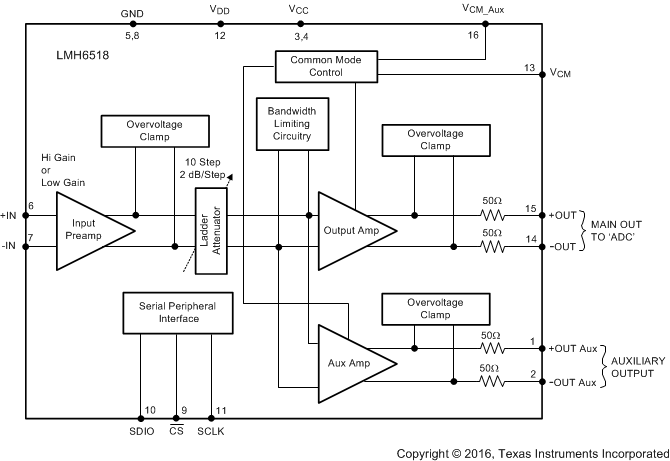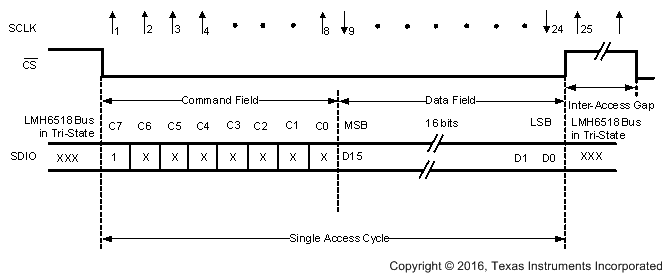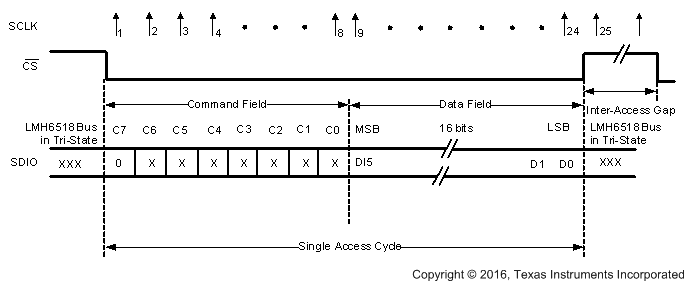SNOSB21D May 2008 – September 2016 LMH6518
PRODUCTION DATA.
- 1 Features
- 2 Applications
- 3 Description
- 4 Revision History
- 5 Pin Configuration and Functions
- 6 Specifications
- 7 Detailed Description
- 8 Application and Implementation
- 9 Power Supply Recommendations
- 10Layout
- 11Device and Documentation Support
- 12Mechanical, Packaging, and Orderable Information
7 Detailed Description
7.1 Overview
The LMH6518 device is a digitally-controlled variable gain amplifier (DVGA) which is designed specifically as an oscilloscope analog front end (AFE). This device samples an analog voltage and conditions it for the analog to digital converter (ADC) input. It is specifically designed to drive TI's giga sample ADCs which have 100-Ω input impedance and 800-mVPP full scale input voltage.
7.2 Functional Block Diagram

7.3 Feature Description
The LMH6518 offers several unique features in addition to being a general purpose digital variable gain amplifier (DVGA).
7.3.1 Input Preamplifier
The LMH6518 has a fully differential preamplifier which has a consistent 150-kΩ impedance across all gain settings. The LMH6518 is also driven with a single-ended signal source. The preamplifier has two gain settings. See Input and Output Considerations for details.
7.3.1.1 Primary Output Amplifier
The LMH6518 has two nearly identical amplifiers. The output amplifier was designed as the primary output amplifier. It features an internal 100-Ω termination for interfacing with 100-Ω input impedance ADCs. The output amplifier has a common mode voltage control pin which sets the output common mode of the amplifier.
7.3.1.2 Auxiliary Amplifier
The LMH6518 has a second output amplifier that was designed to provide a trigger signal when used as an oscilloscope AFE. The auxiliary amplifier has all of the features of the output amplifier and provides a duplicate signal for use in trigger circuits. The auxiliary amplifier has a common mode voltage control pin which sets the output common mode of the amplifier.
7.3.2 Overvoltage Clamp
THe LMH6518 features two levels of clamps used to protect the amplifier and the ADC from voltage transients. These clamps are placed after the input preamplifier and also after the final output amplifier. The clamp voltages are set using the SPI bus.
7.3.3 Attenuator
The primary gain control feature of the LMH65418 is the digital attenuator. The attenuator controls the overall gain of the amplifier. The attenuator has a range of 0 dB to 20 dB of attenuation.
7.3.4 Digital Control Block
The LMH6518 has digitally controlled gain as well as digitally controlled voltage clamps and digitally controlled bandwidth. If it is not used, this block can also disable the auxiliary amplifier. Logic Functions has details on the digital control registers and programming.
7.4 Device Functional Modes
7.4.1 Primary Amplifier
The main functional mode of the LMH6518 is as an AFE providing gain, voltage clamping, and frequency limiting. In this mode, the gain, bandwidth, and voltage swing are all programmable using the SPI control block.
7.4.2 Auxiliary Output
The secondary functional mode of the LMH6518 is the auxiliary output. This output is nearly identical to the primary amplifier. The only difference is that the auxiliary output has slightly lower distortion performance. The auxiliary output was designed to provide a trigger signal when used as an oscilloscope AFE.
7.5 Programming
7.5.1 Logic Functions
The following LMH6518 functions are controlled using the SPI-1 compatible bus:
- Filters (20, 100, 200, 350, 650, 750 MHz or full bandwidth)
- Power mode (Full power or auxiliary high impedance, Hi-Z)
- Preamp (HG or LG)
- Attenuation ladder (0 dB to 20 dB, 10 states)
- LMH6518 state write or read back
The SPI-1 bus uses 3.3-V logic. SDIO is the serial digital input-output which writes to the LMH6518 or reads back from it. SCLK is the bus clock with chip select function controlled by CS.
 Figure 54. Serial Interface Protocol, Read Operation
Figure 54. Serial Interface Protocol, Read Operation
 Figure 55. Serial Interface Protocol, Write Operation
Figure 55. Serial Interface Protocol, Write Operation
 Figure 56. Read Timing
Figure 56. Read Timing
 Figure 57. Write Timing
Figure 57. Write Timing
Table 1. Data Field
| FILTER | PREAMP | LADDER ATTENUATION | |||||||||||||
|---|---|---|---|---|---|---|---|---|---|---|---|---|---|---|---|
| D15 (MSB) |
D14 | D13 | D12 | D11 | D10 | D9 | D8 | D7 | D6 | D5 | D4 | D3 | D2 | D1 | D0 (LSB) |
| X | 0 | 0 | 0 | 0 | 0 = Full power 1 = Aux Hi-Z |
0 | See Table 3 | 0 | 0 = LG 1 = HG |
See Table 4 | |||||
SPACER
NOTE
Bits D5, D9, and D11 to D14 must be 0. Otherwise, device operation is undefined and specifications are not ensured.
Table 2. Default Power-On Reset Condition
| FILTER | PREAMP | LADDER ATTENUATION | |||||||||||||
|---|---|---|---|---|---|---|---|---|---|---|---|---|---|---|---|
| D15 (MSB) |
D14 | D13 | D12 | D11 | D10 | D9 | D8 | D7 | D6 | D5 | D4 | D3 | D2 | D1 | D0 (LSB) |
| 0 | 0 | 0 | 0 | 0 | 0 | 0 | 0 | 0 | 0 | 0 | 0 | 1 | 0 | 1 | 0 |
Table 3. Filter Selection Data Field
| FILTER | BANDWIDTH (MHz) | ||
|---|---|---|---|
| D8 | D7 | D6 | |
| 0 | 0 | 0 | Full |
| 0 | 0 | 1 | 20 |
| 0 | 1 | 0 | 100 |
| 0 | 1 | 1 | 200 |
| 1 | 0 | 0 | 350 |
| 1 | 0 | 1 | 650 |
| 1 | 1 | 0 | 750 |
| 1 | 1 | 1 | Unallowed |
SPACER
NOTE
All filters are low-pass, single pole roll-off and operate on both main and auxiliary outputs. These filters are intended as signal path bandwidth and noise limiting.
Table 4. Ladder Attenuation Data Field
| LADDER ATTENUATION | BANDWIDTH (dB) | |||
|---|---|---|---|---|
| D3 | D2 | D1 | D0 | |
| 0 | 0 | 0 | 0 | 0 |
| 0 | 0 | 0 | 1 | −2 |
| 0 | 0 | 1 | 0 | −4 |
| 0 | 0 | 1 | 1 | −6 |
| 0 | 1 | 0 | 0 | −8 |
| 0 | 1 | 0 | 1 | −10 |
| 0 | 1 | 1 | 0 | −12 |
| 0 | 1 | 1 | 1 | −14 |
| 1 | 0 | 0 | 0 | −16 |
| 1 | 0 | 0 | 1 | −18 |
| 1 | 0 | 1 | 0 | −20 |
| 1 | 0 | 1 | 1 | Unallowed |
| 1 | 1 | 0 | 0 | Unallowed |
| 1 | 1 | 0 | 1 | Unallowed |
| 1 | 1 | 1 | 0 | Unallowed |
| 1 | 1 | 1 | 1 | Unallowed |
SPACER
NOTE
An unallowed SPI-1 state may result in undefined operation where device behavior is not ensured.